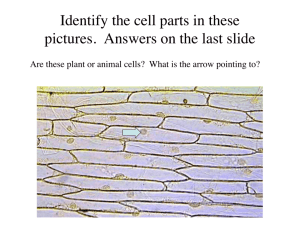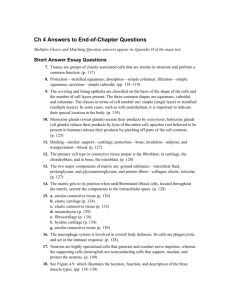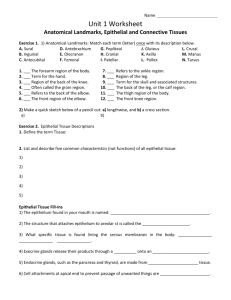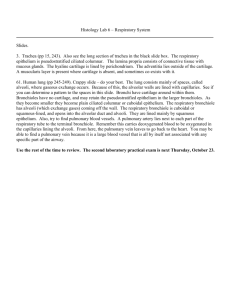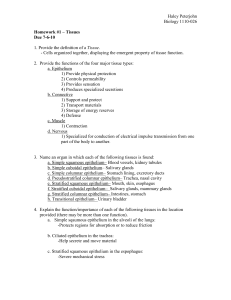HISTOLOGY USMLE CLASS FOR MD4.
advertisement
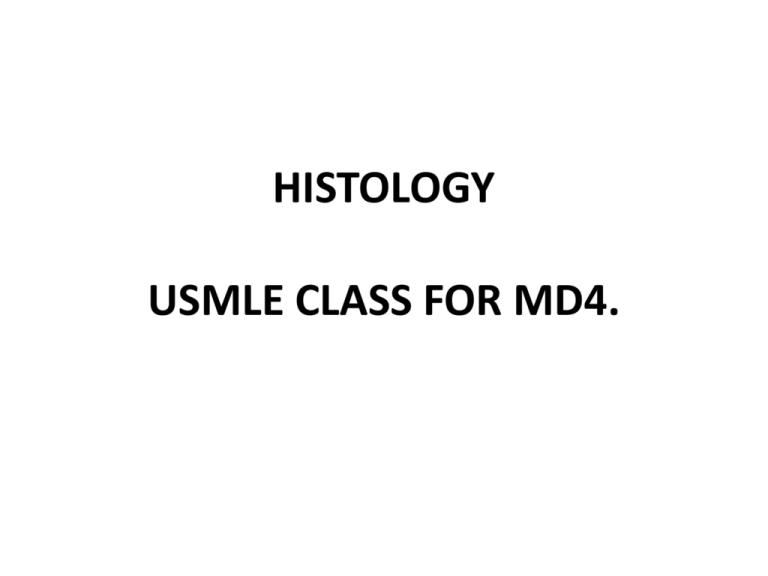
HISTOLOGY USMLE CLASS FOR MD4. 1. A pathologist uses monoclonal antibodies against several intermediate filament proteins and finds that a tumor section stains positive for cytokeratin only. The tumor most likely originated from which of the following tissues? A.Connective B.Epithelial C.Glial D.Muscle E.Neural 2. Two proteins, kinesin and dynein, are isolated from samples of the neural tissue from experimental animals. These proteins are functionally associated with which of the following cell structures? A. Nissl substance B. Microtubules C. Membrane lipids D. Intermediate filament E. Lysosomes 3. Microtubules A. Are composed of actin B. Make up the mitotic spindle C. Can be divided into five different groups based on chemical composition D. Are composed of both actin and myosin E. Are composed of myosin 4. An 11-year-old boy presents with ciliary dyskinesia, sinusitis, and bronchiectasis. He has had persistent infections and otitis media since birth. A PA radiograph shows dextrocardia, and he has a negative saccharin test. In the cross-section of the cilium shown below, which of the following is primarily affected in this disorder? A.Structure A B.Structure B C.Structure C D.Structure D E.Structure E 5. Microfilaments A. Are composed of actin B. Make up the mitotic spindle C. Can be divided into five different groups based on chemical composition D. Are composed of both actin and myosin E. Are composed of myosin 6. Identify the tissue below with asterisk A. Simple columnar epithelium B. Simple cuboidal epithelium C. Simple squamous epithelium D. Transitional epithelium E. Pseudostratified epithelium 7. In the electron micrograph below, the structure labeled B primarily does which of the following? A. Forms a spot weld between cells B. Interacts with actin in the cytoplasm of the apical cytosol C. Facilitates communication between adjacent cells D. Seals membranes between cells E. Moves microvilli 8. The epithelium type as seen in this photomicroscopic image is best classified as A. Simple suamous epithelium B. Transitional epithelium C. Stratified squamous epithelium, keratinized D. Stratified squamous epithelium, non- keratinized E. Pseudostratified columnar epithelium 9. An oophorectomized monkey is treated with high doses of estrogen. Which of the following changes is most likely to occur in the endometrium after 1 year of treatment? A. Atrophy B. Hyperplasia C. Hypertrophy D. Hypoplasia E. Metaplasia 10. A 50-year-old man comes to the physician because of a cough productive of large quantities of mucus for 6 months. He has smoked 1 pack of cigarettes daily for 25 years. Which of the following cell types is the most likely cause of the increase in this patient's secretion of mucus? A. Columnar ciliated epithelial cells B. Goblet cells C. Interstitial cells D. Macrophages E. Pneumocyte epithelial cells 11. A surgical pathology specimen from a 24year-old woman seen at a reproductive medicine clinic demonstrates a ciliated columnar epithelium. From which of the following locations in the female genital tract was the biopsy obtained? A. Cervix B. Endometrium C. Fallopian tube D. Ovary E. Vagina 12. A periodic acid Schiff (PAS) reaction is very useful in histological and pathological preparations to visualize basement membranes. The PAS reaction is best explained by A. High concerntration of cations within the basement membrane B. Presence of type IX collagen moieties in the basement membrane C. Intracellular cytoskeleton proteins complexed with proteins in the basement membrane D. Association of carbohydrate- rich moieties of proteoglycans in the basement membrane E. High concerntration of anions within the basement membrane 13. Shown below is a freeze-fracture replica of the boundary between two cells. Which of the following is illustrated by the pointed arrow? A. Desmosome B. Gap junction C. Hemidesmosome D. Tonofilaments E. Zonula occludens 14. A 63-year- old man has blood- streaked stools and constipation. Barium enema shows a right- sided obstructing lesion. Surgery is performed, and pathologic evaluation reveals a well- differentiated, colonic adenocarcinoma. Observation of a hematoxylin and eosinstained microscopic slide from the specimen reveals that the nuclei of the cells are blue. What is the basis for this observation? A. Eosin binds to carbohydrates B. Eosin binds to lipids C. Eosin binds to nucleic acids D. Hematoxylin binds to lipids E. Hematoxylin binds to nucleic acids 15. A 27-year-old male presents to the doctor with complaints of "heartburn" and painful, sour-tasting acid reflux that has not been alleviated by over-the-counter medications. An endoscopic exam is performed and a biopsy of the distal esophagus is taken. Microscopic examination of the tissue shows normal tissue without pathologic changes. What type of mucosa is normal for the distal esophagus? A. Ciliated, columnar epithelium B. Keratinized, stratified, squamous epithelium C. Non-ciliated, columnar epithelium D. Non-keratinized, simple, squamous epithelium E. Non-keratinized, stratified, squamous epithelium F. Pseudostratified, columnar epithelium 16. In the adult, neurons are an example of which of the following? A. Continuously dividing cells B. Labile cells C. Permanent cells D. Quiescent cells E. Stable cells 17. Which of the following is lined by a serosa? A. Genitourinary tract B. Peritoneal cavity C. Respiratory tract D. Alimentary canal E. All of the above are lined by a mucosa 18. What type of gland secretes its product through a duct or tube? A. Endocrine gland B. Multicellular gland C. Exocrine gland D. All of the above E. None of the above 19. What forms the brush border? A. Microvilli B. Stereocilia C. Cilia D. Keratinization E. Both a and b 20. What type of tissue lines blood vessels? A. Simple squamous epithelium B. Simple cuboidal epithelium C. Simple columnar epithelium D. Stratified squamous epithelium E. Transitional epithelium 21. What type of tissue lines the bladder? A. Simple squamous epithelium B. Simple cuboidal epithelium C. Simple columnar epithelium D. Stratified squamous epithelium E. Transitional epithelium 22. What type of epithelium is associated with goblet cells? A. Simple squamous epithelium B. Simple cuboidal epithelium C. Simple columnar epithelium D. Stratified squamous epithelium E. Pseudostratified 23. What do you call the space where a chondrocyte sits in? A. Space of Disse B. Space of Mall C. Vacuole D. Lacuna E. Howship's Lacuna 24. What stain would be best to demonstrate the elastic fibers in elastic cartilage? A. Wright's stain B. Hematoxylin and eosin stain C. Sudan stain D. Silver impregnation E. Resorcin fuchsin and orcein 25. Which type of cartilage is found in the walls of the eustachian tube? A. Hyaline cartilage B. Elastic cartilage C. Fibrocartilage D. All of the above E. None of the above 26. Which type of cartilage forms the skeleton of the fetus? A. Hyaline cartilage B. Elastic cartilage C. Fibrocartilage D. All of the above E. None of the above 27. What type of tissue makes up the "Adam's apple"? A. Hyaline cartilage B. Fibrocartilage C. Elastic cartilage D. Both a and b E. Both a and c 28. Which type of cartilage forms the intervertebral disc? A. Hyaline cartilage B. Elastic cartilage C. Fibrocartilage D. All of the above E. None of the above 29. Which type of cartilage forms the hammer, anvil and stirrup? A. Hyaline cartilage B. Elastic cartilage C. Fibrocartilage D. All of the above E. None of the above 30. Which type of cartilage is highly vascular? A. Hyaline cartilage B. Elastic cartilage C. Fibrocartilage D. All of the above E. None of the above


